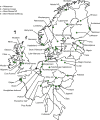Taxonomic and functional turnover are decoupled in European peat bogs
- PMID: 29079831
- PMCID: PMC5660083
- DOI: 10.1038/s41467-017-01350-5
Taxonomic and functional turnover are decoupled in European peat bogs
Abstract
In peatland ecosystems, plant communities mediate a globally significant carbon store. The effects of global environmental change on plant assemblages are expected to be a factor in determining how ecosystem functions such as carbon uptake will respond. Using vegetation data from 56 Sphagnum-dominated peat bogs across Europe, we show that in these ecosystems plant species aggregate into two major clusters that are each defined by shared response to environmental conditions. Across environmental gradients, we find significant taxonomic turnover in both clusters. However, functional identity and functional redundancy of the community as a whole remain unchanged. This strongly suggests that in peat bogs, species turnover across environmental gradients is restricted to functionally similar species. Our results demonstrate that plant taxonomic and functional turnover are decoupled, which may allow these peat bogs to maintain ecosystem functioning when subject to future environmental change.
Conflict of interest statement
All authors declare no competing financial interests.
Figures






References
-
- Hooper DU, et al. A global synthesis reveals biodiversity loss as a major driver of ecosystem change. Nature. 2012;486:105–108. - PubMed
-
- Duprè C, et al. Changes in species richness and composition in European acidic grasslands over the past 70 years: the contribution of cumulative atmospheric nitrogen deposition. Glob. Change Biol. 2009;16:344–357. doi: 10.1111/j.1365-2486.2009.01982.x. - DOI
-
- Field CD, et al. The role of nitrogen deposition in widespread plant community change across semi-natural habitats. Ecosystems. 2014;17:864–877. doi: 10.1007/s10021-014-9765-5. - DOI
Publication types
MeSH terms
Substances
Associated data
LinkOut - more resources
Full Text Sources
Other Literature Sources
Molecular Biology Databases

